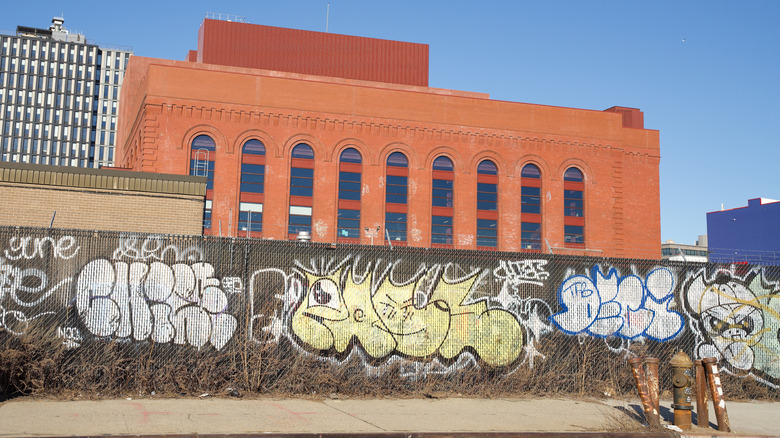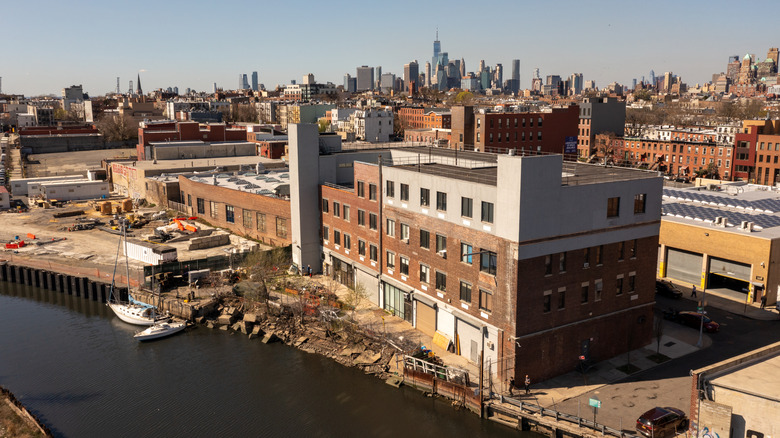Rooftop Lounges And Art Studios Now Rise Above A Long Polluted Canal In New York's New 'It District'
When you're in New York City, you can miss a lot of its most interesting areas and historic streets if you avoid Brooklyn. Two of America's hottest neighborhoods, Prospect Heights and Clinton Hill, embody some of the most lavish, brownstone-lined aspects of Brooklyn. Further west towards the Upper New York Bay, you'll land in the more industrial part of the borough, where areas like the artsy waterfront neighborhood of Red Hook are some of Brooklyn's best-kept secrets, filled with converted warehouses and a grittier feel, despite becoming a hotspot for developers. One neighborhood that most glaringly captures this blend of industrial influence and high-end developments is Gowanus, which sprawls out around a canal that's one of the most polluted in the country.
The murky waters of the Gowanus Canal wind between rundown warehouses and oil storage tanks, and once facilitated Brooklyn's industrial boom in the 19th century. Gas plants, coal yards, and shipyards all set up shop along the canal so that materials could be transported to and from the industrial sites, carrying waste and pollutants in tandem. The consequences of its past life as an industrial gutter still characterize the canal. Watching rainbow ripples from coal tar is a common local activity, and the bottom of the canal is blanketed by a mucky residue lovingly known as "black mayonnaise." Still, the canal has been an Environmental Protection Agency (EPA) Superfund cleanup site since 2010, and the neighborhood has become quite popular since then, to the point that Crain's New York Business dubbed it "a new 'it' district." Sleek high-rises, indie venues, and a giant rooftop hangout make up Gowanus' new character.
Explore the Gowanus Canal, from industrial relics to art studios
The Gowanus Canal is nearly 2 miles long, bordered by a waterfront walkway. Since receiving funding from the EPA, the canal's gone through extensive cleaning and remodeling, and you'll notice dredgers doing the work of clearing through the murk. Some beautification efforts have been made, too, including an added terracotta facade and new planted areas. Walk along the canal to the Carroll Street Bridge, which was built in 1889 and is only one of four retractable bridges in the country.
From here, it's about a 15-minute walk to the Powerhouse Arts facility, one of Gowanus's most interesting buildings. It started out as a power plant in 1904, supplying electricity for Brooklyn's Rapid Transit System. After being decommissioned in the 1950s, it later became a squatting area and graffiti haven known as "The Batcave." By the 2000s, it developed its own community of homeless youth, but the community became overrun with drug issues and violence, leading them to be expelled permanently by 2006. It was finally renovated and converted into Powerhouse Arts, and its design left features from the power station and graffiti from its punk community intact. Graffiti-filled stages and vault ceiling art studios now make up its space, where you can take a class, browse a zine fair, or attend a discussion.
Trendy places to eat, drink, and hang in Gowanus
A block over from Powerhouse Arts, you'll see a somewhat out-of-place brick and glass building that houses a Whole Foods. When Whole Foods opened here in 2013, it was still a pretty industrial neighborhood with more affordable living. It was controversial at the time, with some in the community worried that it would drive up prices and change the neighborhood character (indeed, luxury high-rises started appearing in Gowanus around the same time), while others welcomed it as a sign of revival. It's been in place for over a decade now and has even become a trendy spot on its own. Make your way up to the store's rooftop, where there's a restaurant and beer garden with views of the city skyline. There's also a greenhouse on the roof that supplies produce for the store.
Walk along Third Avenue to pass some of Gowanus's trendiest spots. A few blocks south of the Whole Foods is Four and Twenty Blackbirds, a bakery with a rating of 4.3 out of five on Tripadvisor that specializes in homemade pies. By Third Avenue and President Street, there's Finback Brewery, which was converted from a warehouse. Two blocks up is Kick Axe Throwing, where you can practice throwing axes in a lodge-like setting with a bar and light bites.
You can get to Gowanus in about 40 minutes from Grand Central Station by taking the Line Four or Five, then transferring to the R train until you reach the Union Street station. You could also bike there — one of the cheapest ways to navigate New York City — in under an hour from Midtown Manhattan.


